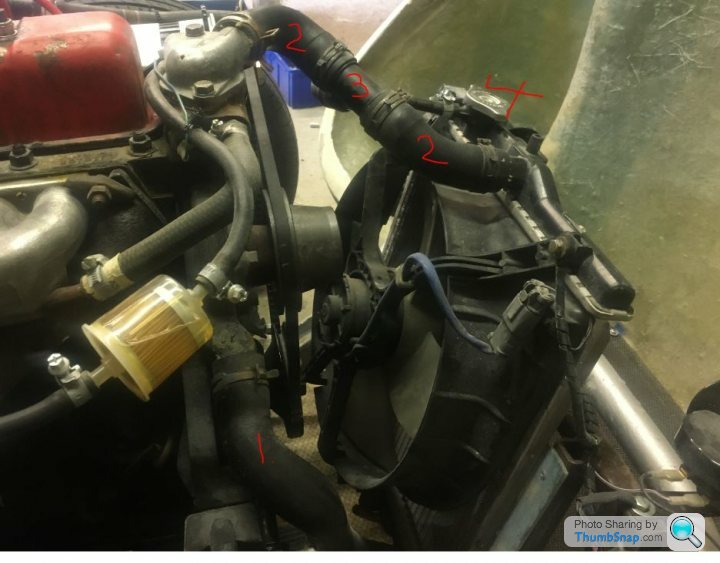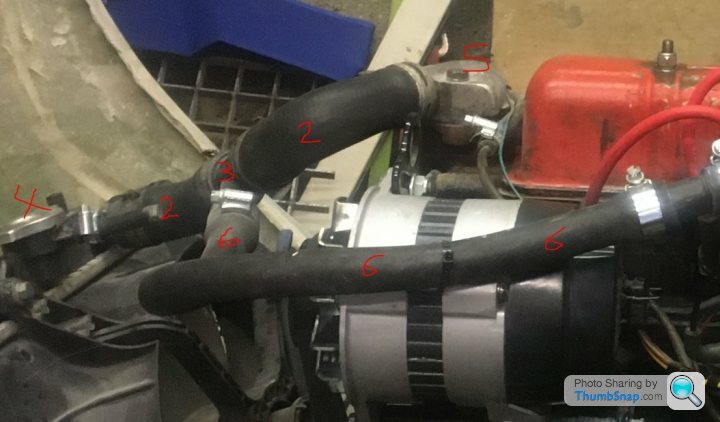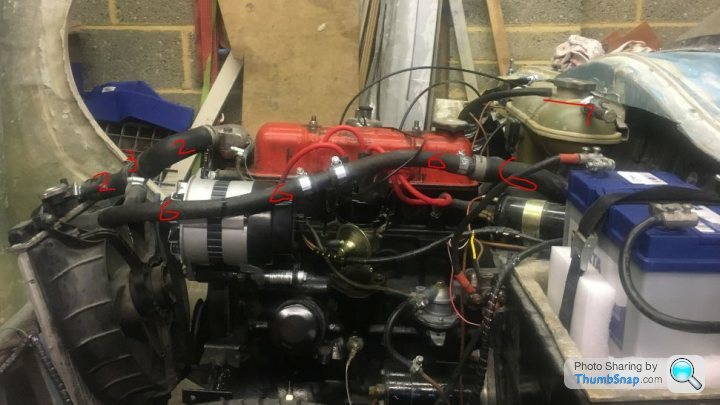Cooling System Problem
Discussion
So I am running a Herald 13/60 engine in my kit car. The top of the radiator sits lower than the thermostat housing due to the shape of the bonnet. So, in the hose which connects the bottom of the radiator to the thermostat housing I have added a T piece, one limb of which is connected to an expansion tank. The expansion tank sits slightly higher than the top of the thermostat housing.
Just got the car on the road - 50 miles since first MOT. I was out in the car this afternoon and noticed that the temp guage was reading very high. First thought was that the temp controlled radiator fan had failed but that all checked out fine. Then I noticed that the radiator felt cooler than anything else and that the expansion tank was bubbling. I carefully removed the pressure cap from the expansion tank (it was full to the top) and lifted it higher above the engine. There was a gurgling noise, the level in the tank dropped back to normal, the radiator heated up and the fan kicked in.
I had presumed that with the exapnsion tank being higher than both the thermostat housing and radiator, any trapped air would make its way to the expansion tank. But today, the air seems to have collected in the radiator. What am I missing?
Just got the car on the road - 50 miles since first MOT. I was out in the car this afternoon and noticed that the temp guage was reading very high. First thought was that the temp controlled radiator fan had failed but that all checked out fine. Then I noticed that the radiator felt cooler than anything else and that the expansion tank was bubbling. I carefully removed the pressure cap from the expansion tank (it was full to the top) and lifted it higher above the engine. There was a gurgling noise, the level in the tank dropped back to normal, the radiator heated up and the fan kicked in.
I had presumed that with the exapnsion tank being higher than both the thermostat housing and radiator, any trapped air would make its way to the expansion tank. But today, the air seems to have collected in the radiator. What am I missing?
Thought some photos might be better than a schematic.
In photo below (looking from offside), 1 is the bottom radiator hose from the water pump. 2 is the radiator top hose to thermostat housing. 3 is the T piece and 4 is the radiator cap.

In photo below (looking from nearside), 5 is the thermostat housing and 6 is the hose that comes off the T piece and feeds the expansion tank.

In photo below (looking from nearside), 6 is the hose that connects the T piece to the expansion tank (7).

The radiator filler has a pressure cap and drain. The drain is sealed with a piece of hose which has a bolt epoxied into it.
The exspansion tank has a pressure cap, bottom feed (hose 6 connected) and 2 top drains, both drains have been sealed.
So what would cause the water to move to the expansion tank and leave the radiator full of air?
In photo below (looking from offside), 1 is the bottom radiator hose from the water pump. 2 is the radiator top hose to thermostat housing. 3 is the T piece and 4 is the radiator cap.

In photo below (looking from nearside), 5 is the thermostat housing and 6 is the hose that comes off the T piece and feeds the expansion tank.

In photo below (looking from nearside), 6 is the hose that connects the T piece to the expansion tank (7).

The radiator filler has a pressure cap and drain. The drain is sealed with a piece of hose which has a bolt epoxied into it.
The exspansion tank has a pressure cap, bottom feed (hose 6 connected) and 2 top drains, both drains have been sealed.
So what would cause the water to move to the expansion tank and leave the radiator full of air?
Thanks everyone,
@stevieturbo says '....IMO there needs to be a bleed point from the stat housing to the header tank where your "7" is'.
and @Mexscort says '......degas connection. On your setup this can go from the top of the rad by the filler cap (the overflow), to the top of the expansion bottle'.
My radiator is from a Honda Civic and the filler 'vent' is always open (thats why I balnked it off) rather than open when the cap is under the right pressure.
So, if I fit a hose between the radiator vent and the top side (rather than filler neck vent) of the expansion bottle will this prevent air being trapped in the stat housing?
@stevieturbo says '....IMO there needs to be a bleed point from the stat housing to the header tank where your "7" is'.
and @Mexscort says '......degas connection. On your setup this can go from the top of the rad by the filler cap (the overflow), to the top of the expansion bottle'.
My radiator is from a Honda Civic and the filler 'vent' is always open (thats why I balnked it off) rather than open when the cap is under the right pressure.
So, if I fit a hose between the radiator vent and the top side (rather than filler neck vent) of the expansion bottle will this prevent air being trapped in the stat housing?
@stevieturbo says 'It does need a bleed/degas or whatever some might call it, but that is not it.'.
So I could either:
a) drill/tap thermostat housing and connect a hose from here into the side (rather than bottom) of the explansion tank. Cannot see a suitable fitting for this on the Internet.
b) put an in inline radiator filler neck (with a recovery cap) into the top hose. If I used a longish flexi for the top hose then I would be able to vent the system by lifting the neck above the thermostat housing when I fill.
c) Put a second inline T piece in the top hose (as close to the thermostat housing as possible) and vent this into the sideof the expansion tank.
Am I on the right lines here?
So I could either:
a) drill/tap thermostat housing and connect a hose from here into the side (rather than bottom) of the explansion tank. Cannot see a suitable fitting for this on the Internet.
b) put an in inline radiator filler neck (with a recovery cap) into the top hose. If I used a longish flexi for the top hose then I would be able to vent the system by lifting the neck above the thermostat housing when I fill.
c) Put a second inline T piece in the top hose (as close to the thermostat housing as possible) and vent this into the sideof the expansion tank.
Am I on the right lines here?
I have changed the system so that hose 6 connects the 25mm spout on the bottom of the expansion bottle to a T piece in the bottom radiator hose (as per advice above).
Rather than fit an air bleed into the top radiator hose or thermostat housing, I remembered that my initial plan had been to unbolt the radiator and lift it above the thermostat housing when filling the cooling system.
So I filled the system with the radiator filler above the thermostat and ran the engine with the expansion bottle cap in place. As the engine got warm, I replaced the radiator cap and ran the engine until everything got nice and hot (temp gauge read normal). I then turned the engine off an allowed to cool, at which point I removed the radiator cap and found the radiator was not full to the top. So I loosened the expansion tank cap, water started to come out of the radiator filler and so I repaced the radiator cap. Went through this cycle a number of times (radiator was clearly getting very hot) before lowering the radiator down and bolting it back into position.
On road testing the car this afternoon the temperature gauge remained very low but when I got back and stopped in the garage the expansion tank starting venting water, all hoses felt hard (there seemed to be bubbling/boiling in some of the hoses) but the radiator was quite cool (thought this was due to have been out on the road and the air temp being quite low).I also noticed that a couple of new water leaks had developed and assumed that the cooling system was over pressurising? After the engine had cooled, I removed the radiator cap and it looks as if there is no water in the radiator.
So having bled the system, something seems to have caused the radiator to fill with air and its contents to spew out of the expansion tank. How can the system over-pressurise when the expansion tank cap can vent?
Rather than fit an air bleed into the top radiator hose or thermostat housing, I remembered that my initial plan had been to unbolt the radiator and lift it above the thermostat housing when filling the cooling system.
So I filled the system with the radiator filler above the thermostat and ran the engine with the expansion bottle cap in place. As the engine got warm, I replaced the radiator cap and ran the engine until everything got nice and hot (temp gauge read normal). I then turned the engine off an allowed to cool, at which point I removed the radiator cap and found the radiator was not full to the top. So I loosened the expansion tank cap, water started to come out of the radiator filler and so I repaced the radiator cap. Went through this cycle a number of times (radiator was clearly getting very hot) before lowering the radiator down and bolting it back into position.
On road testing the car this afternoon the temperature gauge remained very low but when I got back and stopped in the garage the expansion tank starting venting water, all hoses felt hard (there seemed to be bubbling/boiling in some of the hoses) but the radiator was quite cool (thought this was due to have been out on the road and the air temp being quite low).I also noticed that a couple of new water leaks had developed and assumed that the cooling system was over pressurising? After the engine had cooled, I removed the radiator cap and it looks as if there is no water in the radiator.
So having bled the system, something seems to have caused the radiator to fill with air and its contents to spew out of the expansion tank. How can the system over-pressurise when the expansion tank cap can vent?
Really apprecaite this help - thank you everyone.
@stevieturbo - I hadnt realised that the air bleed needs to be always available (rather that just for filling). So I need a permanent and always open bleed from the highest point (ie thermostat hosusing) to the middle (ie above the water level but below the pressure cap) of the exampnsion tank. Thus, any air that finds its way into the thermostat housing will vent into the expansion tank and be replaced by the cooling system drawing water from the expansion tank?
@GreenV8s, the more I think about it the less certain I become about the geometry of the colling system. You say about getting the air to a presssure cap where it can vent out. Surely a pressure cap will only allow air to vent if it is either opened or has an open bleed to the expansion tank?
@tapkajohnD, the kit car is a Sammio (some photos here: http://www.madabout-kitcars.com/forum/showthread.p... I am not clear about the difference between a header tank and refill tank.Is it that my expansion tank does not have a feed from the top of the system and so it is only dealing with coolant exapnsion/contraction and not preventing airlocks?.
@stevieturbo - I hadnt realised that the air bleed needs to be always available (rather that just for filling). So I need a permanent and always open bleed from the highest point (ie thermostat hosusing) to the middle (ie above the water level but below the pressure cap) of the exampnsion tank. Thus, any air that finds its way into the thermostat housing will vent into the expansion tank and be replaced by the cooling system drawing water from the expansion tank?
@GreenV8s, the more I think about it the less certain I become about the geometry of the colling system. You say about getting the air to a presssure cap where it can vent out. Surely a pressure cap will only allow air to vent if it is either opened or has an open bleed to the expansion tank?
@tapkajohnD, the kit car is a Sammio (some photos here: http://www.madabout-kitcars.com/forum/showthread.p... I am not clear about the difference between a header tank and refill tank.Is it that my expansion tank does not have a feed from the top of the system and so it is only dealing with coolant exapnsion/contraction and not preventing airlocks?.
Thanks again @stevieturbo,
Please be assured that I dont doubt anything that you have said. My questions are all about trying to make sure that I understand how the system should work.
The other thing that I am wondering is whether a stuck thermostat would cause the contents of the raidator to be pushed into the expansion bottle and out through its drain under pressure?
Please be assured that I dont doubt anything that you have said. My questions are all about trying to make sure that I understand how the system should work.
The other thing that I am wondering is whether a stuck thermostat would cause the contents of the raidator to be pushed into the expansion bottle and out through its drain under pressure?
@tapkajohnD - thanks for that image. I have seen some other Sammio fixes but not that one which looks very neat. So the themostat housing is connected into the top of the pressurised reservoir (which makes it the highest point at which air will collect) and the radiator top connection goes into the bottom of the reservoir. Guess that this would be no better/worse than venting thermostat housing into the pressurised reservoir?
Gassing Station | Engines & Drivetrain | Top of Page | What's New | My Stuff



